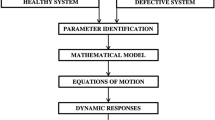Abstract
Gearbox for wind turbine must be designed to have the sufficient structural strength to sustain the extreme torque and forces transferred from rotor blades. Traditionally, the structural analysis of gearbox has been made using the simplified FEM models in which the contacts between gear teeth are replaced with the equivalent forces acting on the gear shafts, because the consideration of the detailed internal gear transmission system requires a huge number of degrees of freedom. But, the traditional method can neither accurately reflect the gear transmission forces, nor is it preferable for the dynamic analysis. In order to solve these problems, a structural analysis method considering the tooth contact of internal gear system is introduced in this paper. The actual tooth contact between a pair of gears is modeled with spring elements and the spring constants are determined through the stiffness analysis of gear teeth. The current analysis technique is justified through the comparison with the simplified gear system model and applied to the structural analysis of a 2-stage differentialtype gearbox for wind turbine.
Similar content being viewed by others
References
A. D. Hansen and L. H. Hansen, Wind turbine concept market penetration over 10 years (1995–2004), Wind Energy, 10 (2007) 81–97.
I. Paraschivoiu, Wind turbine design with emphasis on darrieus concept, Ecole Polytechnique de Montreal, Canada (2002).
J. F. Walker and N. Jenkins, Wind energy technology, John Wiley & Sons, New York (1997).
American gear manufacturers association, American National Standard for Design and Specification of Gearboxes for Wind Turbines ANSI/AGMA/AWEA 6006-103, Virginia, USA (2003).
D. C. Quarton, The evolution of wind turbine design analysis — a twenty year progress review, Wind Energy, 1 (1998) 5–24.
M. O. L. Hansen, Aerodynamics of wind turbines, Earthscan, London, UK (2008).
W. Musial, S. Butterfield and B. McNiff, Improving wind turbine gearbox reliability, European Wind Energy Conference, NREL/CP-500-41548, Milan, Italy (2007).
H. N. Özgüven and D. R. Housner, Mathematical models used in gear dynamics — a review, Journal of Sound and Vibration, 121(3) (1988) 383–411.
V. Ramamurti, P. Gautam and A. Kothari, Computer-aided design of a two-stage gearbox, Advances in Engineering Software, 28 (1997) 73–82.
G. Lethé, D. Cuyper, J. Kang, M. Furman and D. Kading, Simulating dynamics, durability and noise emission of wind turbine in a single CAE environment, Journal of Mechanical Science and Technology, 23 (2009) 1089–1093.
J. B. Ooi, X. Wang, C. S. Tan, J. H. Ho and Y. P. Lim, Modal and stress analysis of gear train design in portal axle using finite element modeling and simulation, Journal of Mechanical Science and Technology, 26(2) (2012) 575–589.
R. Li, C. Yang, T. Lin, X. Chen and L. Wang, Finite element simulation of the dynamical behavior of a speed-increase gearbox, Journal of Materials Processing Technology, 150 (2004) 170–174.
J. Peeters, D. Vandepitte and P. Sas, Flexible multibody model of a three-stage planetary gearbox in a wind turbine, Proceedings of ISMA 2004, 3923–3942.
S. J. Drew and B. J. Stone, Torsional damping measurements for a gearbox, Mechanical Systems and Signal Processing, 19 (2005) 1096–1106.
M. C. Garcia, M. A. Sanz-Bobi and J. del Pico, SIMAP: intelligent system for predictive maintenance allocation to the health condition monitoring of a wind turbine gearbox, Computers in Industry, 57(6) (2006) 552–568.
V. B. Torrance, Wind profiles over a suburban site and wind effects on a half-scale model building, Building Science, 7(1) (1972) 1–12.
Midas IT, On-line user’s manual of midas NFX, Gyeonggi, Korea (2010).
Author information
Authors and Affiliations
Corresponding author
Additional information
Recommended by Associate Editor Chang-Wan Kim
Jin-Rae Cho received his B.S. degree in Aeronautical Engineering from Seoul National University in 1983. He then received his M.S. and Ph.D. degrees from University of Texas at Austin in 1993 and 1995, respectively. He served as an Editor of KSME International Journal and Journal of Mechanical Science and Technology. Dr. Cho is currently a vice director of the Research Institute of Midas IT Co. Ltd. Dr. Cho’s current research interests include adaptive computational method, natural element method, computational tire mechanics, fluidstructure interaction, functionally graded materials, footwear biomechanics and offshore renewable energy.
Rights and permissions
About this article
Cite this article
Cho, JR., Jeong, KY., Park, MH. et al. Finite element structural analysis of wind turbine gearbox considering tooth contact of internal gear system. J Mech Sci Technol 27, 2053–2059 (2013). https://doi.org/10.1007/s12206-013-0521-0
Received:
Revised:
Accepted:
Published:
Issue Date:
DOI: https://doi.org/10.1007/s12206-013-0521-0



